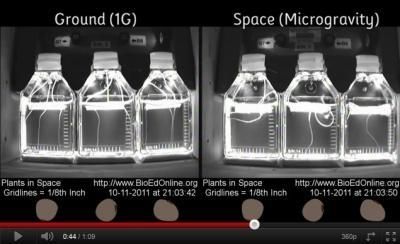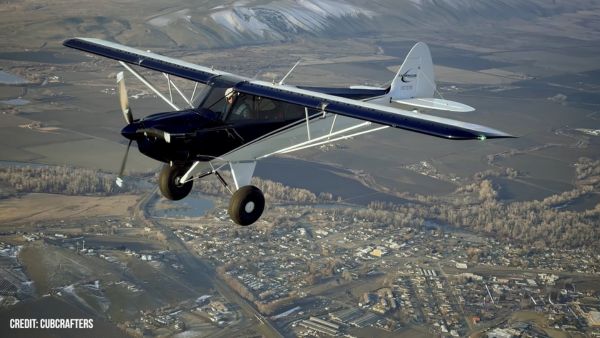Sat, Oct 29, 2011
How Does Your Garden Grow ... In Microgravity?
A unique science project designed to sow the excitement of
scientific discovery in students is sprouting this week aboard the
International Space Station. The Plants in Space project will allow
students and teachers to examine root growth in microgravity and
compare the results with those from plants used in their own
ground-based experiments.
NSRBI YouTube Frame Capture

The National Space Biomedical Research Institute (NSBRI) is
funding the project. It began Tuesday, Sept. 20, when space station
astronauts planted Brassica rapa seeds during the first of four
scheduled five-day trials. The project's primary scientific goal is
to investigate the influence of light on root orientation. "More
than 31 million students have participated in educational
demonstrations on the space station, and more than a million
students have done experiments linked to the space station," said
NASA's International Space Station Program Scientist Julie
Robinson. "It's a powerful force motivating young people to pursue
careers that look to the future."
During the trials, astronauts plant seeds in a clear
nutrient-filled gelatin. They will take daily photographs of root
growth during each trial. Students will design and conduct their
own experiments with the help of a teacher's guide developed by the
NSBRI. Students will be able to compare observations and results of
their investigations to the station experiments and the project's
ground-based control. "An important aspect of the Plants in Space
project is that it is not cookbook science" said Nancy P. Moreno,
NSBRI education and outreach program principal investigator,
professor of allied health sciences at Baylor College of Medicine
(BCM) and senior associate director of its Center for Educational
Outreach. "Unfortunately, too often in science class, kids follow a
procedure, get a predetermined result and really don't experience
the excitement of science and the whole process of discovery. We
know that if we enable students to ask their own questions, design
their own experiments and discover their own answers, they are more
likely to develop a greater interest in science."
The Plants in Space project seeks to determine if white light,
heavy in the blue spectrum, can influence the direction of root
growth in microgravity. Previous research has shown that plant
roots respond weakly to blue light. The project also will study the
effects, if any, of seed orientation on the direction of root
growth. The experiment design calls for mounting seeds in different
orientations on a piece of balsawood, then placing them on top of
the growth medium.
Data gained from the primary and secondary scientific
investigations may help develop systems and techniques so future
astronauts can grow their own food during extended spaceflights to
destinations such as Mars.
More News
Aero Linx: Space Medicine Association (SMA) The Space Medicine Association of the Aerospace Medical Association is organized exclusively for charitable, educational, and scientific>[...]
Jamming Denotes emissions that do not mimic Global Navigation Satellite System (GNSS) signals (e.g., GPS and WAAS), but rather interfere with the civil receiver's ability to acquir>[...]
Aero Linx: Warbirds of America The EAA Warbirds of America, a division of the Experimental Aircraft Association in Oshkosh, Wisconsin, is a family of owners, pilots and enthusiasts>[...]
"From New York to Paris, this life-size replica of the Webb Telescope inspired communities around the world and, in doing so, invited friends and families to explore the cosmos tog>[...]
Hold-In-Lieu Of Procedure Turn A hold-in-lieu of procedure turn shall be established over a final or intermediate fix when an approach can be made from a properly aligned holding p>[...]
 ANN's Daily Aero-Linx (04.17.24)
ANN's Daily Aero-Linx (04.17.24) ANN's Daily Aero-Term (04.17.24): Jamming
ANN's Daily Aero-Term (04.17.24): Jamming ANN's Daily Aero-Linx (04.18.24)
ANN's Daily Aero-Linx (04.18.24) Aero-News: Quote of the Day (04.18.24)
Aero-News: Quote of the Day (04.18.24) ANN's Daily Aero-Term (04.18.24): Hold-In-Lieu Of Procedure Turn
ANN's Daily Aero-Term (04.18.24): Hold-In-Lieu Of Procedure Turn



